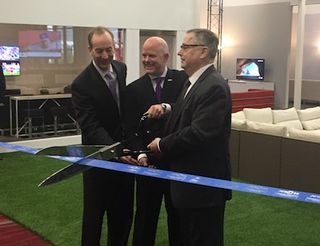NAB 2016: A Lot of Firsts for ATSC 3.0

Complete Coverage: NAB Show 2016
Las Vegas — Sam Matheny, CTO for the National Association of Broadcasters (NAB), sounded genuinely excited when he and representatives from the Consumer Technology Association (CTA) and Advanced Television Systems Committee (ATSC) unveiled the ATSC 3.0 Consumer Experience at the NAB Show.
“This is a great day,” he said. “It builds off all the work … of the last several years.”
More than five years, to be exact, according to Mark Richer, president of ATSC. That’s how long “thousands of engineers” have been at work fine-tuning the world’s first IP-based broadcast system. At the NAB Show, the results of hat work will finally be shared with the world.
Related: Chernock—FCC Spectrum Auction Has ATSC 3.0 Implications
“Quite simply, it’s the future of broadcasting,” Richer said. Over-the-air delivery of everything from targeted advertising, 4K video and high dynamic range (HDR) are in the cards if ATSC 3.0 plays out the way he hopes. Already the CTA, NAB, Advanced Warning and Response Network Alliance (AWARN) and America’s Public Television Stations (APTS) have petitioned the FCC for approval of the core transmission technology of ATSC 3.0.
“[ATSC 3.0] will see new products and ways for consumers to get services in the home,” said Brian Markwalter, senior VP of research and standards for CTA.
Broadcasting & Cable Newsletter
The smarter way to stay on top of broadcasting and cable industry. Sign up below
The ATSC 3.0 Consumer Experience is giving NAB Show attendees a broader look at the in-home benefits of the standard, including next-generation audio delivery, advanced emergency warning services, and targeted advertising. A live video from the Las Vegas Convention Center floor — showing two women chatting next to a bowl of bright, fake fruit — was being broadcast live to the Consumer Experience, using ATSC 3.0.
“In addition to spectacular 4K video with HDR, the new standard offers immersive audio — immediate benefits that a growing audience of Ultra HDTV owners can appreciate,” said Anne Schelle, managing director of Pearl TV, a group of more than 200 local broadcasters that backs ATSC 3.0.”But bigger, better pictures and sound are just the beginning. Because the new standard is IP-based, just like the internet.
Related: NAB 2016: UHD, ATSC 3.0 Score High Among Consumers, Survey Says
“Now local stations will be able to offer new services like VOD and targeted advertising to reach specific types of viewers.”
Pearl TV and Samsung Electronics partnered up at NAB to show off advanced, targeted advertising for the home, the ability for non-real-time data can be delivered to devices using ATSC 3.0, and gateway receivers and Wi-Fi transmitters needed to deliver content using the standard.
“This next generation TV standard opens the doors for VOD functionality, delivered by broadcasters, so that viewers will have even more choices and flexibility when watching TV,” said John Godfrey, senior VP of public policy for Samsung Electronics America. “At NAB, we are thrilled to showcase a potential vision for the future where shows can be downloaded overnight and stored locally, giving viewers an enormous amount of content immediately available on their television.”
Related: One Media, TeamCast Experimenting With ATSC 3.0, SFN Tests
LG Electronics also used the NAB Show to unveil a new wireless network antenna that can receive and process ATSC 3.0 broadcast signals, and redistribute them via Wi-Fi.
“In addition to showing how such consumer-friendly products will support the rollout of next-gen broadcasting, this device, built around the world’s first ATSC 3.0 demodulator chip, exemplifies our progress,” said Dr. Jong Kim, senior VP for LG Electronics and president of LG’s Zenith R&D lab in the United States.
LG also announced a partnership with Sinclair Broadcast Group to conduct the first ATSC 3.0-enabled emergency alert broadcast. The technology — dubbed AWARN — will beef up the disaster alert information consumers will be able to receive, by waking up devices and including over-the-air features like HTML pages and evacuation routes. The first-ever broadcast of the technology was transmitted by Sinclair from Las Vegas’ Black Mountain on Channel 45, to the Las Vegas Convention Center.
Related: ATSC 3.0 Passes Key Test, But Is It Ready to Graduate?
“The first AWARN broadcast is timely as the FCC considers adoption of the next-generation broadcast standard,” said Mark Aitken, Sinclair’s VP for advanced technology. ”Sinclair views advanced emergency alerting as one of the major enhancements enabled by next-gen TV. Combining robust transmission, single-frequency networks and rich media alerts will mean reaching millions of Americans simultaneously during emergencies, regardless of device.”
